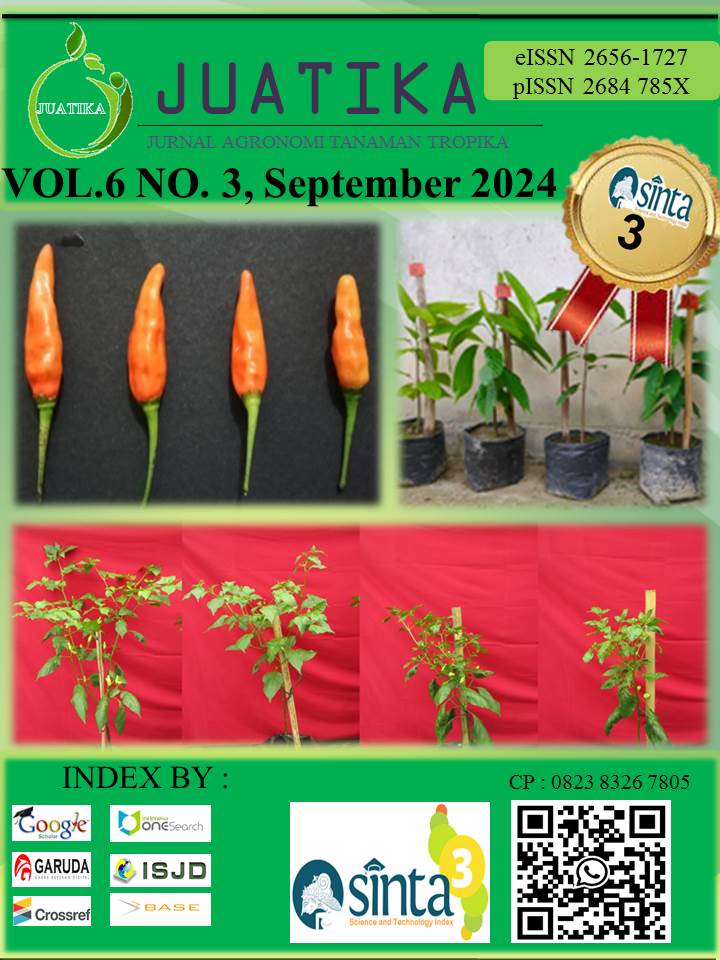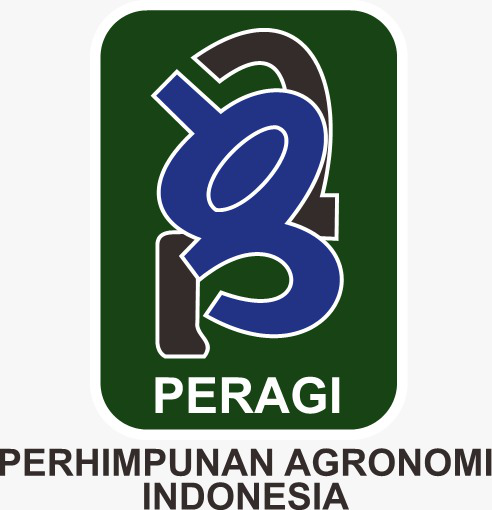Response of Nutrient Levels of Oil Palm Leaves (Elaeis guineensis Jacq.) to Polyhalite and KCl Fertilizers Application in Dystrudepts Soil
Abstract
Oil palm (Elaeis guineensis) is a significant plantation crop extensively cultivated in Indonesia, particularly in the Riau region, where it is often grown on marginal lands, such as typical dystrudepts. Low soil pH and limited water-holding capacity necessitating effective fertilization management strategies characterize typic Dystrudepts. One approach to address these challenges is the application of slow-release fertilizers. Polyhalite, a mineral fertilizer, contains slow-release nutrients including potassium (K), calcium (Ca), magnesium (Mg), and sulfur (S). Given that oil palm plants have a high demand for potassium to support their growth and productivity, providing substantial quantities of readily available potassium fertilizers, such as potassium chloride (KCl) is essential. The synergistic application of polyhalite and KCl is anticipated to enhance plant nutrient absorption, thereby improving leaf nutrient levels. This study aims to evaluate the effects of Polyhalite fertilizer, both alone and in combination with KCl fertilizer, on the leaf nutrient levels of oil palm plants. A Completely Randomized Design (CRD) was employed, consisting of five treatment factors: Control (NPK), Polyhalite at 25% combined with KCl at 75%, Polyhalite at 50% combined with KCl at 50%, Polyhalite at 75% combined with KCl at 25%, and Polyhalite at 100%. Each treatment was replicated three times, resulting in 60 plants across four plants per treatment. The data collected from the research will be analyzed using Analysis of Variance (ANOVA), followed by the 5% Duncan's New Multiple Range Test (DNMRT). The findings indicate that the application of Polyhalite at 75% in combination with KCl at 25% significantly increased the levels of potassium, calcium, and magnesium in the leaves of the oil palm plants
Downloads
References
Afridona Herlin. (2021). Statistik Kelapa Sawit Provinsi Riau.
Awaludin, K., Boestami, R., Amir, Y., & Barat, S. (2021). Comparative response of gambir leaf (Uncaria gambir Roxb.) compost to the growth of palm oil seeds (Elaeis guineensis Jacq.) in early breedings.
Churka Blum, S., Lehmann, J., Solomon, D., Caires, E. F., & Alleoni, L. R. F. (2013). Sulfur forms in organic substrates affecting S mineralization in soil. Geoderma, 200–201, 156–164. https://doi.org/10.1016/j.geoderma.2013.02.003
Havlin, J. L., Tisdale, S. L., Nelson, W. L., & Beaton, J. D. (2013). Soil Fertility and Fertilizers (8th ed.). Pearson Education.
Kering, M. K., Butler, T. J., Biermacher, J. T., Mosali, J., & Guretzky, J. A. (2013). Effect of potassium and nitrogen fertilizer on switchgrass productivity and nutrient removal rates under two harvest systems on a low potassium soil. Bioenergy Research, 6(1), 329–335. https://doi.org/10.1007/s12155-012-9261-8
Manorama, K., Behera, S. K., & Suresh, K. (2021). Establishing optimal nutrient norms in leaf and soil for oil palm in India. Industrial Crops and Products, 174, 114223. https://doi.org/10.1016/j.indcrop.2021.114223
Marschner, P. (2012). Mineral Nutrition of Higher Plants (3rd ed.). Academic Press.
Maulana Amry, I., Agustina Putri, L. P., & Sofia Hanafiah, D. (2019). Respon dan heritabilitas kelapa sawit (Elaeis guineensis Jacq.) tipe K++ dan K- terhadap aplikasi pupuk KCl di pembibitan pre-nursery. Jurnal Agroekoteknologi, 7(1). https://jurnal.usu.ac.id/agroekoteknologi
Nazari Yudhi Ahmad. (2020). Kondisi status hara tanah dan jaringan tanaman kelapa sawit (Elaeis guineensis Jacq.) BPSBP Kalimantan Selatan. Ziraa’ah, 45, 274–284.
Pangondian Sihaan, H., Wawan, W., & Khoiri, M. A. (2023). Intensity of soil treatment and frequency of inorganic fertilizer application on nutrient levels and growth of palm oil (Elaeis guineensis Jacq.) at the replanting stage. Jurnal Agronomi Tanaman Tropika (JUATIKA), 5(1). https://doi.org/10.36378/juatika.v5i1.2833
Rahmawati Linda, & Santoso Porwo Eko. (2017). Penerapan metode LSU (Leaf Sampling Unit) untuk analisis kandungan hara pada sampel daun kelapa sawit (Elaeis guineensis Jacq.). Agrisains, 03, 14–17.
Saito, S., & Uozumi, N. (2020). Calcium-regulated phosphorylation systems controlling uptake and balance of plant nutrients. Frontiers in Plant Science, 11. https://doi.org/10.3389/fpls.2020.00044
Sembiring, I. S., Wawan, & Adiwirman. (2020). Pengaruh pemberian dolomit dan NPK slow-release fertilizer terhadap fisiologi dan pertumbuhan jagung manis (Zea mays saccharata Sturt) pada tanah gambut. Jurnal Agronomi Tanaman Tropika, 2(1), 46–62.
Sudjadi, & Effendi, S. (1991). Soil Fertility Constraints in Indonesia and Methods of Improvement.
Suntari, R., Sutopo, S., & Gilang Maudyansa, A. (2020). Pengaruh aplikasi pupuk polyhalite dan KCl terhadap kadar K dan pertumbuhan bibit tanaman jeruk pamelo (Citrus maxima) di kebun percobaan Balitjestro, Batu. Jurnal Tanah dan Sumberdaya Lahan, 7(1), 87–92. https://doi.org/10.21776/ub.jtsl.2020.007.1.11
Survey Staff, S. (2022). Keys to Soil Taxonomy.
Sutopo, S., & Aji, T. G. (2020). Aplikasi polyhalite sebagai pengganti ZK dan pengaruhnya terhadap kadar K, Mg, dan S daun, produksi, dan mutu buah jeruk siam. Agrosains: Jurnal Penelitian Agronomi, 22(2), 114. https://doi.org/10.20961/agsjpa.v22i2.44249
Vale, F., & Girotto, E. S. (2022). Fertilization efficiency with polyhalite mineral: A multi-nutrient fertilizer.
Wahyu Hidayat, A., Saputra, R., Noviatul Zahra, D., & Fajar, I. (2023). Sumbangan perladangan kelapa sawit Indonesia kepada pembangunan mampan. Journal of Creative Future and Heritage, 11, 113–123.
Wahyuni, M., & Manurung, W. A. (2020). Hubungan hara K-Mg dan pengaruhnya terhadap kadar hara daun bibit kelapa sawit (Elaeis guineensis Jacq.). Jurnal Agrosains dan Teknologi, 5(1).
White, P. J., & Broadley, M. R. (2001). Chloride in soils and its uptake and movement within the plant: A review. Annals of Botany, 88(6), 967–988. https://doi.org/10.1006/anbo.2001.1540
Yermiyahu, U., Zipori, I., Faingold, I., Yusopov, L., Faust, N., & Bar-Tal, A. (2017). Polyhalite as a multi-nutrient fertilizer – potassium, magnesium, calcium, and sulfate. Israel Journal of Plant Sciences, 64(3–4), 145–157. https://doi.org/10.1163/22238980-06401001
Yusup, C. A., Eris, D. D., & Priwiratama, H. (2023). Alisin dan polifenol sebagai fungisida organik potensial untuk menekan pertumbuhan patogen penyebab penyakit bercak daun kelapa sawit. Warta Pusat Penelitian Kelapa Sawit, 28(3), 146–153. https://doi.org/10.22302/iopri.war.warta.v28i3.113
Copyright (c) 2024 Cynthia Bernadetta Silalahi, Arman Effendi, Wawan, Nursiana Lubis, Hamdani Fadila

This work is licensed under a Creative Commons Attribution 4.0 International License.
Authors who publish with Jurnal Agronomi Tanaman Tropika (JUATIKA) agree to the following terms:
Authors retain copyright and grant the Jurnal Agronomi Tanaman Tropika (JUATIKA) right of first publication with the work simultaneously licensed under a Creative Commons Attribution License (CC BY 4.0) that allows others to share (copy and redistribute the material in any medium or format) and adapt (remix, transform, and build upon the material for any purpose, even commercially) with an acknowledgment of the work's authorship and initial publication in Jurnal Agronomi Tanaman Tropika (JUATIKA).
Authors are able to enter into separate, additional contractual arrangements for the non-exclusive distribution of the journal's published version of the work (e.g., post it to an institutional repository or publish it in a book), with an acknowledgment of its initial publication in Jurnal Agronomi Tanaman Tropika (JUATIKA). Authors are permitted and encouraged to post their work online (e.g., in institutional repositories or on their website) prior to and during the submission process, as it can lead to productive exchanges, as well as earlier and greater citation of published work.







 More Information
More Information


